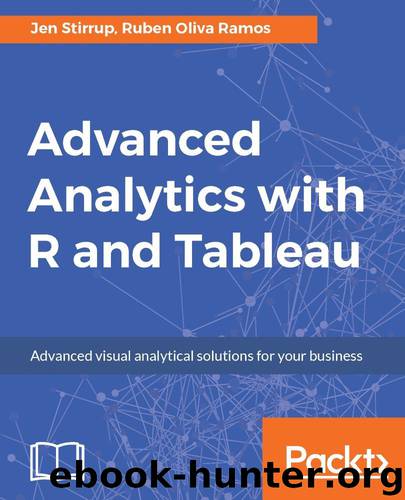Advanced Analytics with R and Tableau by Jen Stirrup & Ruben Oliva Ramos

Author:Jen Stirrup & Ruben Oliva Ramos [Stirrup, Jen]
Language: eng
Format: azw3
Publisher: Packt Publishing
Published: 2017-08-21T16:00:00+00:00
Sharing our data analysis using Tableau
R gives you good diagnostic information to help you take the next step in your analysis, which is to visualize the results.
Interpreting the results
Statistics provides us with a method of investigation where other methods haven't been able to help, and their success or failure isn't clear to many people. If we see a correlation and think that the relationship is obvious, then we need to think again. Correlation can help people to insinuate causation. It's often said that correlation is not causation, but what does this mean? Correlation is a measure of how closely related two things are. We can use other statistical methods, such as structural equation modeling, to help us to identify the direction of the relationship, if it exists, using correlated data. It's a complex field in itself, and it isn't covered in this book; the main point here is to show that this is a complex question.
How does correlation help us here? For our purposes, the most interesting statistic is the coefficient of determination, denoted R2 and pronounced R-squared, which indicates how well data points fit a statistical model –sometimes simply a line or curve. R-squared measures how close the data is to the fitted regression line. It is also known as the coefficient of multiple determination for multiple regression.
It can be explained by R-squared = Explained variation/Total variation, and it is always explained as a percentage between 0 and 100%: Generally speaking, the higher the R-squared value, then the better the model fits the data. In our example, our model fit is found to be 69%, which is reasonably successful. We would need to map out the data to visualize it better, and to see if the model fits a linear line or not.
Regression problems in business are trying to predict a continuous variable, such as the price of a car, or the amount of profit. In this example, we have created a model that can be used to predict sales. As a next step, we could try to pick apart the model to understand what variables are contributing to the success of the model, and which ones are not contributing.
Download
This site does not store any files on its server. We only index and link to content provided by other sites. Please contact the content providers to delete copyright contents if any and email us, we'll remove relevant links or contents immediately.
Sass and Compass in Action by Wynn Netherland Nathan Weizenbaum Chris Eppstein Brandon Mathis(7966)
Supercharging Productivity with Trello by Brittany Joiner(7322)
Mastering Tableau 2023 - Fourth Edition by Marleen Meier(7091)
Inkscape by Example by István Szép(6962)
Secrets of the JavaScript Ninja by John Resig Bear Bibeault(6736)
Visualize Complex Processes with Microsoft Visio by David J Parker & Šenaj Lelić(6644)
Build Stunning Real-time VFX with Unreal Engine 5 by Hrishikesh Andurlekar(5671)
Design Made Easy with Inkscape by Christopher Rogers(4995)
Customizing Microsoft Teams by Gopi Kondameda(4536)
Business Intelligence Career Master Plan by Eduardo Chavez & Danny Moncada(4435)
Extending Microsoft Power Apps with Power Apps Component Framework by Danish Naglekar(4149)
Salesforce Platform Enterprise Architecture - Fourth Edition by Andrew Fawcett(4012)
Linux Device Driver Development Cookbook by Rodolfo Giometti(4008)
Pandas Cookbook by Theodore Petrou(4001)
The Tableau Workshop by Sumit Gupta Sylvester Pinto Shweta Sankhe-Savale JC Gillet and Kenneth Michael Cherven(3815)
Exploring Microsoft Excel's Hidden Treasures by David Ringstrom(3289)
TCP IP by Todd Lammle(3117)
Applied Predictive Modeling by Max Kuhn & Kjell Johnson(3006)
Drawing Shortcuts: Developing Quick Drawing Skills Using Today's Technology by Leggitt Jim(2975)
